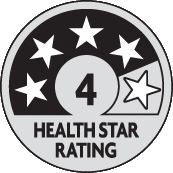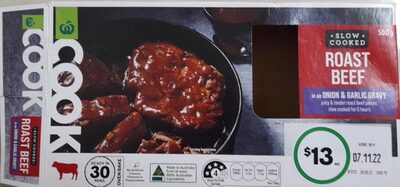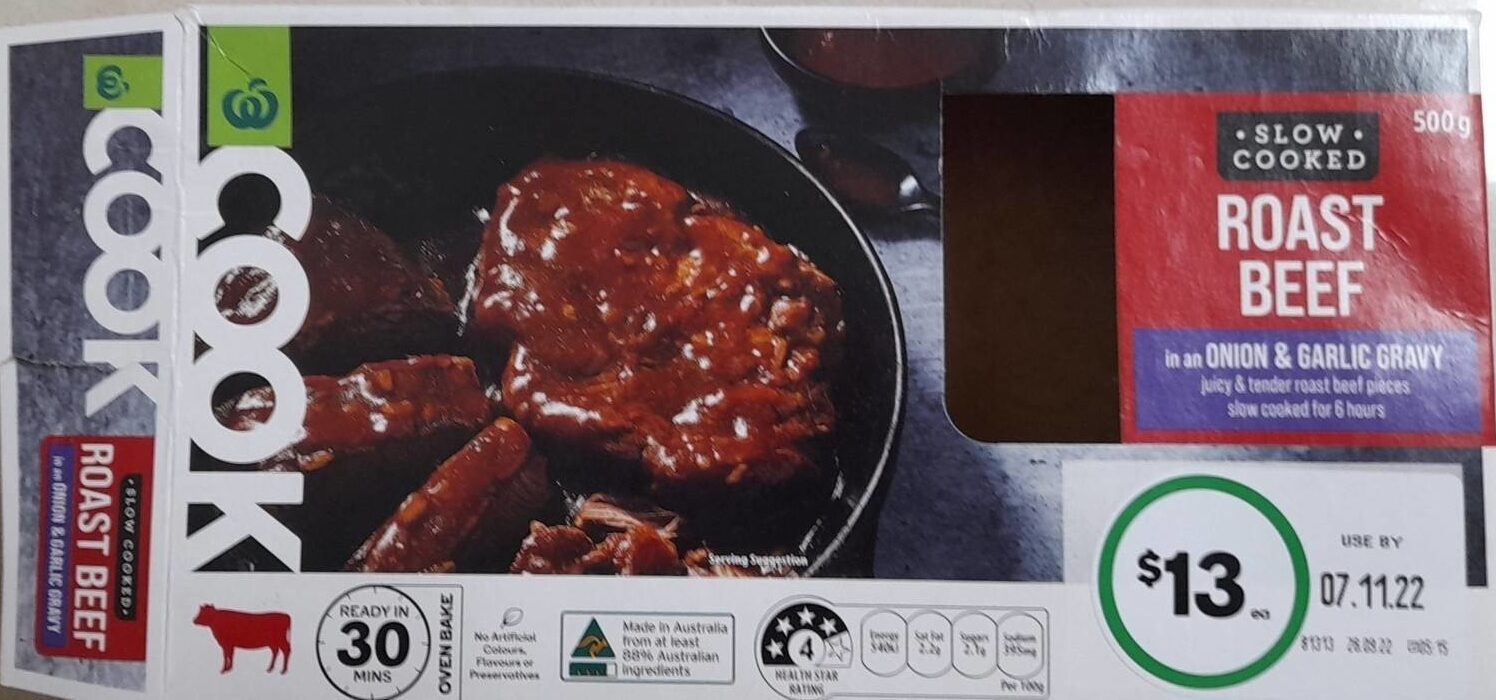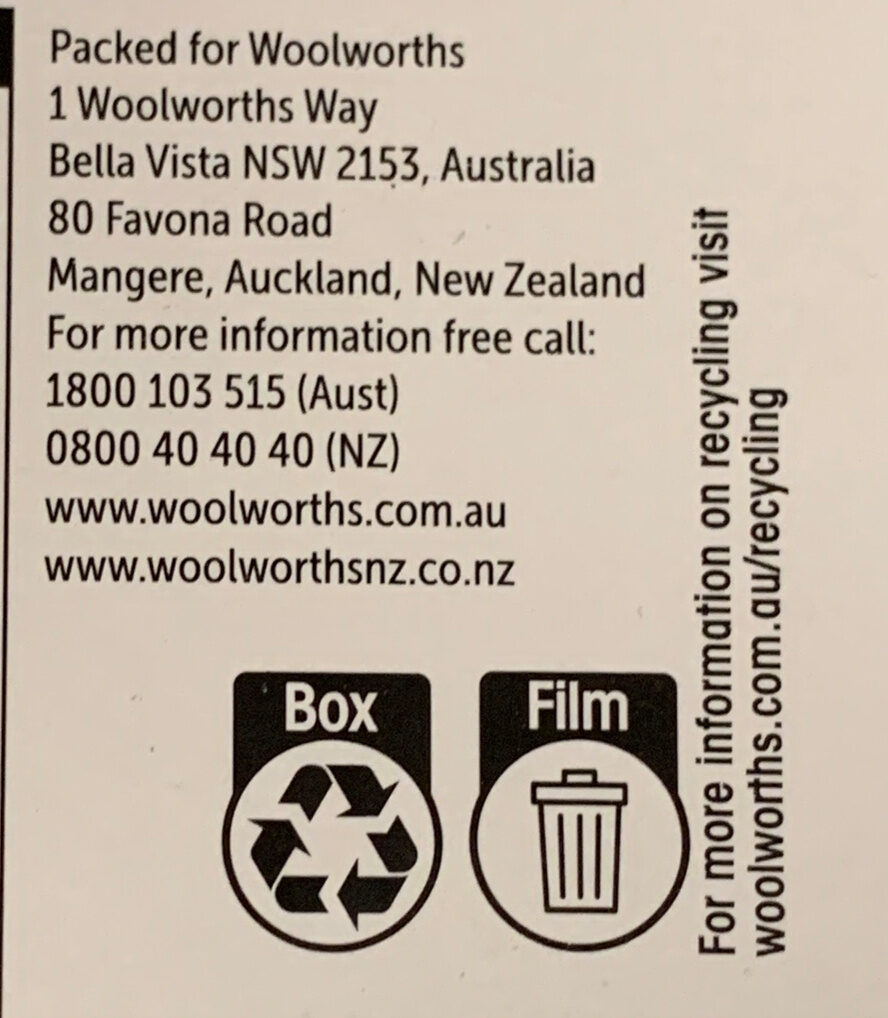Help us make food transparency the norm!
As a non-profit organization, we depend on your donations to continue informing consumers around the world about what they eat.
The food revolution starts with you!
Slow cooked roast beef - Woolworths Cook - 500g
Slow cooked roast beef - Woolworths Cook - 500g
This product page is not complete. You can help to complete it by editing it and adding more data from the photos we have, or by taking more photos using the app for Android or iPhone/iPad. Thank you!
×
Barcode: 9339687280940 (EAN / EAN-13)
Quantity: 500g
Brands: Woolworths Cook
Categories: Meats and their products, Beef and its products, Meals, Meats, Beef, Meals with meat, Beef dishes, Microwave meals, Roast beef
Labels, certifications, awards:
Australian made, Health Star Rating, Health Star Rating 4
Origin of ingredients: Australia
Link to the product page on the official site of the producer: http://woolworths.com.au
Stores: Woolworths
Countries where sold: Australia
Matching with your preferences
Health
Ingredients
-
30 ingredients
Marinated Australian Beef (85%), (Beef (90%), Water, Acidity Regulators (451, Sodium Carbonate), Salt, Bamboo Fibre, Sugar, Spice Extract), Onion Gravy Sauce (15%) (Water, Dehydrated Vegetables (Tomato, Onion (6%), Garlic (<1%)), Sugar, Thickeners (1422, Guar Gum, Xanthan Gum), Maltodextrin, Salt, Natural Colour (Caramell), Yeast Extract, Natural Flavour), Thickeners (1414, Carrageenan).Allergens: Beef
Food processing
-
Ultra processed foods
Elements that indicate the product is in the 4 - Ultra processed food and drink products group:
- Additive: E1414 - Acetylated distarch phosphate
- Additive: E1422 - Acetylated distarch adipate
- Additive: E407 - Carrageenan
- Additive: E412 - Guar gum
- Additive: E415 - Xanthan gum
- Additive: E451 - Triphosphates
- Ingredient: Colour
- Ingredient: Flavouring
- Ingredient: Maltodextrin
- Ingredient: Thickener
Food products are classified into 4 groups according to their degree of processing:
- Unprocessed or minimally processed foods
- Processed culinary ingredients
- Processed foods
- Ultra processed foods
The determination of the group is based on the category of the product and on the ingredients it contains.
Additives
-
E1422 - Acetylated distarch adipate
Acetylated distarch adipate: Acetylated distarch adipate -E1422-, is a starch that is treated with acetic anhydride and adipic acid anhydride to resist high temperatures. It is used in foods as a bulking agent, stabilizer and a thickener. No acceptable daily intake for human consumption has been determined.Source: Wikipedia
-
E407 - Carrageenan
Carrageenan (E407), derived from red seaweed, is widely employed in the food industry as a gelling, thickening, and stabilizing agent, notably in dairy and meat products.
It can exist in various forms, each imparting distinct textural properties to food.
However, its degraded form, often referred to as poligeenan, has raised health concerns due to its potential inflammatory effects and its classification as a possible human carcinogen (Group 2B) by the International Agency for Research on Cancer (IARC).
Nevertheless, food-grade carrageenan has been deemed safe by various regulatory bodies when consumed in amounts typically found in food.
-
E412 - Guar gum
Guar gum (E412) is a natural food additive derived from guar beans.
This white, odorless powder is valued for its remarkable thickening and stabilizing properties, making it a common ingredient in various food products, including sauces, dressings, and ice creams.
When used in moderation, guar gum is considered safe for consumption, with no known adverse health effects.
-
E415 - Xanthan gum
Xanthan gum (E415) is a natural polysaccharide derived from fermented sugars, often used in the food industry as a thickening and stabilizing agent.
This versatile food additive enhances texture and prevents ingredient separation in a wide range of products, including salad dressings, sauces, and gluten-free baked goods.
It is considered safe for consumption even at high intake amounts.
-
E451 - Triphosphates
Sodium triphosphate: Sodium triphosphate -STP-, also sodium tripolyphosphate -STPP-, or tripolyphosphate -TPP-,- is an inorganic compound with formula Na5P3O10. It is the sodium salt of the polyphosphate penta-anion, which is the conjugate base of triphosphoric acid. It is produced on a large scale as a component of many domestic and industrial products, especially detergents. Environmental problems associated with eutrophication are attributed to its widespread use.Source: Wikipedia
-
E500 - Sodium carbonates
Sodium carbonates (E500) are compounds commonly used in food preparation as leavening agents, helping baked goods rise by releasing carbon dioxide when they interact with acids.
Often found in baking soda, they regulate the pH of food, preventing it from becoming too acidic or too alkaline. In the culinary world, sodium carbonates can also enhance the texture and structure of foods, such as noodles, by modifying the gluten network.
Generally recognized as safe, sodium carbonates are non-toxic when consumed in typical amounts found in food.
-
E500i - Sodium carbonate
Sodium carbonate: Sodium carbonate, Na2CO3, -also known as washing soda, soda ash and soda crystals, and in the monohydrate form as crystal carbonate- is the water-soluble sodium salt of carbonic acid. It most commonly occurs as a crystalline decahydrate, which readily effloresces to form a white powder, the monohydrate. Pure sodium carbonate is a white, odorless powder that is hygroscopic -absorbs moisture from the air-. It has a strongly alkaline taste, and forms a moderately basic solution in water. Sodium carbonate is well known domestically for its everyday use as a water softener. Historically it was extracted from the ashes of plants growing in sodium-rich soils, such as vegetation from the Middle East, kelp from Scotland and seaweed from Spain. Because the ashes of these sodium-rich plants were noticeably different from ashes of timber -used to create potash-, they became known as "soda ash". It is synthetically produced in large quantities from salt -sodium chloride- and limestone by a method known as the Solvay process. The manufacture of glass is one of the most important uses of sodium carbonate. Sodium carbonate acts as a flux for silica, lowering the melting point of the mixture to something achievable without special materials. This "soda glass" is mildly water-soluble, so some calcium carbonate is added to the melt mixture to make the glass produced insoluble. This type of glass is known as soda lime glass: "soda" for the sodium carbonate and "lime" for the calcium carbonate. Soda lime glass has been the most common form of glass for centuries. Sodium carbonate is also used as a relatively strong base in various settings. For example, it is used as a pH regulator to maintain stable alkaline conditions necessary for the action of the majority of photographic film developing agents. It acts as an alkali because when dissolved in water, it dissociates into the weak acid: carbonic acid and the strong alkali: sodium hydroxide. This gives sodium carbonate in solution the ability to attack metals such as aluminium with the release of hydrogen gas.It is a common additive in swimming pools used to raise the pH which can be lowered by chlorine tablets and other additives which contain acids. In cooking, it is sometimes used in place of sodium hydroxide for lyeing, especially with German pretzels and lye rolls. These dishes are treated with a solution of an alkaline substance to change the pH of the surface of the food and improve browning. In taxidermy, sodium carbonate added to boiling water will remove flesh from the bones of animal carcasses for trophy mounting or educational display. In chemistry, it is often used as an electrolyte. Electrolytes are usually salt-based, and sodium carbonate acts as a very good conductor in the process of electrolysis. In addition, unlike chloride ions, which form chlorine gas, carbonate ions are not corrosive to the anodes. It is also used as a primary standard for acid-base titrations because it is solid and air-stable, making it easy to weigh accurately.Source: Wikipedia
Ingredients analysis
-
Palm oil content unknown
Unrecognized ingredients: Marinated-australian-beef, 451, Onion-gravy-sauce, 1422, Caramell, 1414Some ingredients could not be recognized.
We need your help!
You can help us recognize more ingredients and better analyze the list of ingredients for this product and others:
- Edit this product page to correct spelling mistakes in the ingredients list, and/or to remove ingredients in other languages and sentences that are not related to the ingredients.
- Add new entries, synonyms or translations to our multilingual lists of ingredients, ingredient processing methods, and labels.
If you would like to help, join the #ingredients channel on our Slack discussion space and/or learn about ingredients analysis on our wiki. Thank you!
-
Non-vegan
Non-vegan ingredients: BeefSome ingredients could not be recognized.
We need your help!
You can help us recognize more ingredients and better analyze the list of ingredients for this product and others:
- Edit this product page to correct spelling mistakes in the ingredients list, and/or to remove ingredients in other languages and sentences that are not related to the ingredients.
- Add new entries, synonyms or translations to our multilingual lists of ingredients, ingredient processing methods, and labels.
If you would like to help, join the #ingredients channel on our Slack discussion space and/or learn about ingredients analysis on our wiki. Thank you!
-
Non-vegetarian
Non-vegetarian ingredients: BeefSome ingredients could not be recognized.
We need your help!
You can help us recognize more ingredients and better analyze the list of ingredients for this product and others:
- Edit this product page to correct spelling mistakes in the ingredients list, and/or to remove ingredients in other languages and sentences that are not related to the ingredients.
- Add new entries, synonyms or translations to our multilingual lists of ingredients, ingredient processing methods, and labels.
If you would like to help, join the #ingredients channel on our Slack discussion space and/or learn about ingredients analysis on our wiki. Thank you!
-
Details of the analysis of the ingredients
We need your help!
Some ingredients could not be recognized.
We need your help!
You can help us recognize more ingredients and better analyze the list of ingredients for this product and others:
- Edit this product page to correct spelling mistakes in the ingredients list, and/or to remove ingredients in other languages and sentences that are not related to the ingredients.
- Add new entries, synonyms or translations to our multilingual lists of ingredients, ingredient processing methods, and labels.
If you would like to help, join the #ingredients channel on our Slack discussion space and/or learn about ingredients analysis on our wiki. Thank you!
: Marinated Australian Beef 85% (Beef 76.5%, Water, Acidity Regulators (451, Sodium Carbonate), Salt, Bamboo Fibre, Sugar, Spice Extract), Onion Gravy Sauce 15%, Water, Vegetables (Tomato, Onion 0%, Garlic 0%), Sugar, Thickeners (1422, Guar Gum, Xanthan Gum), Maltodextrin, Salt, Natural Colour (Caramell), Yeast Extract, Natural Flavour, Thickeners (1414, Carrageenan)- Marinated Australian Beef -> en:marinated-australian-beef - percent_min: 85 - percent: 85 - percent_max: 85
- Beef -> en:beef - vegan: no - vegetarian: no - percent_min: 76.5 - percent: 76.5 - percent_max: 76.5
- Water -> en:water - vegan: yes - vegetarian: yes - ciqual_food_code: 18066 - percent_min: 1.41666666666667 - percent_max: 8.5
- Acidity Regulators -> en:acidity-regulator - percent_min: 0 - percent_max: 7.08333333333333
- 451 -> en:451 - percent_min: 0 - percent_max: 7.08333333333333
- Sodium Carbonate -> en:e500i - vegan: yes - vegetarian: yes - percent_min: 0 - percent_max: 3.54166666666666
- Salt -> en:salt - vegan: yes - vegetarian: yes - ciqual_food_code: 11058 - percent_min: 0 - percent_max: 0.9875
- Bamboo Fibre -> en:bamboo-fibre - vegan: yes - vegetarian: yes - percent_min: 0 - percent_max: 0.9875
- Sugar -> en:sugar - vegan: yes - vegetarian: yes - ciqual_proxy_food_code: 31016 - percent_min: 0 - percent_max: 0.9875
- Spice Extract -> en:spice-extract - vegan: yes - vegetarian: yes - percent_min: 0 - percent_max: 0.9875
- Onion Gravy Sauce -> en:onion-gravy-sauce - percent_min: 15 - percent: 15 - percent_max: 15
- Water -> en:water - vegan: yes - vegetarian: yes - ciqual_food_code: 18066 - percent_min: 0 - percent_max: 0
- Vegetables -> en:vegetable - vegan: yes - vegetarian: yes - percent_min: 0 - percent_max: 0
- Tomato -> en:tomato - vegan: yes - vegetarian: yes - ciqual_food_code: 20047 - percent_min: 0 - percent_max: 0
- Onion -> en:onion - vegan: yes - vegetarian: yes - ciqual_food_code: 20034 - percent_min: 0 - percent: 0 - percent_max: 0
- Garlic -> en:garlic - vegan: yes - vegetarian: yes - ciqual_food_code: 11000 - percent_min: 0 - percent: 0 - percent_max: 0
- Sugar -> en:sugar - vegan: yes - vegetarian: yes - ciqual_proxy_food_code: 31016 - percent_min: 0 - percent_max: 0
- Thickeners -> en:thickener - percent_min: 0 - percent_max: 0
- 1422 -> en:1422 - percent_min: 0 - percent_max: 0
- Guar Gum -> en:e412 - vegan: yes - vegetarian: yes - percent_min: 0 - percent_max: 0
- Xanthan Gum -> en:e415 - vegan: yes - vegetarian: yes - percent_min: 0 - percent_max: 0
- Maltodextrin -> en:maltodextrin - vegan: yes - vegetarian: yes - percent_min: 0 - percent_max: 0
- Salt -> en:salt - vegan: yes - vegetarian: yes - ciqual_food_code: 11058 - percent_min: 0 - percent_max: 0
- Natural Colour -> en:natural-colours - percent_min: 0 - percent_max: 0
- Caramell -> en:caramell - percent_min: 0 - percent_max: 0
- Yeast Extract -> en:yeast-extract - vegan: yes - vegetarian: yes - percent_min: 0 - percent_max: 0
- Natural Flavour -> en:natural-flavouring - vegan: maybe - vegetarian: maybe - percent_min: 0 - percent_max: 0
- Thickeners -> en:thickener - percent_min: 0 - percent_max: 0
- 1414 -> en:1414 - percent_min: 0 - percent_max: 0
- Carrageenan -> en:e407 - vegan: yes - vegetarian: yes - percent_min: 0 - percent_max: 0
Nutrition
-
Good nutritional quality
⚠ ️Warning: the amount of fiber is not specified, their possible positive contribution to the grade could not be taken into account.⚠ ️Warning: the amount of fruits, vegetables and nuts is not specified on the label, it was estimated from the list of ingredients: 0This product is not considered a beverage for the calculation of the Nutri-Score.
Positive points: 5
- Proteins: 5 / 5 (value: 18.3, rounded value: 18.3)
- Fiber: 0 / 5 (value: 0, rounded value: 0)
- Fruits, vegetables, nuts, and colza/walnut/olive oils: 0 / 5 (value: 0, rounded value: 0)
Negative points: 7
- Energy: 1 / 10 (value: 540, rounded value: 540)
- Sugars: 0 / 10 (value: 2.1, rounded value: 2.1)
- Saturated fat: 2 / 10 (value: 2.2, rounded value: 2.2)
- Sodium: 4 / 10 (value: 395, rounded value: 395)
The points for proteins are counted because the negative points are less than 11.
Nutritional score: (7 - 5)
Nutri-Score:
-
Nutrient levels
-
Fat in moderate quantity (4.4%)
What you need to know- A high consumption of fat, especially saturated fats, can raise cholesterol, which increases the risk of heart diseases.
Recommendation: Limit the consumption of fat and saturated fat- Choose products with lower fat and saturated fat content.
-
Saturated fat in moderate quantity (2.2%)
What you need to know- A high consumption of fat, especially saturated fats, can raise cholesterol, which increases the risk of heart diseases.
Recommendation: Limit the consumption of fat and saturated fat- Choose products with lower fat and saturated fat content.
-
Sugars in low quantity (2.1%)
What you need to know- A high consumption of sugar can cause weight gain and tooth decay. It also augments the risk of type 2 diabetes and cardio-vascular diseases.
Recommendation: Limit the consumption of sugar and sugary drinks- Sugary drinks (such as sodas, fruit beverages, and fruit juices and nectars) should be limited as much as possible (no more than 1 glass a day).
- Choose products with lower sugar content and reduce the consumption of products with added sugars.
-
Salt in moderate quantity (0.988%)
What you need to know- A high consumption of salt (or sodium) can cause raised blood pressure, which can increase the risk of heart disease and stroke.
- Many people who have high blood pressure do not know it, as there are often no symptoms.
- Most people consume too much salt (on average 9 to 12 grams per day), around twice the recommended maximum level of intake.
Recommendation: Limit the consumption of salt and salted food- Reduce the quantity of salt used when cooking, and don't salt again at the table.
- Limit the consumption of salty snacks and choose products with lower salt content.
-
-
Nutrition facts
Nutrition facts As sold
for 100 g / 100 mlCompared to: Beef and its products Energy 540 kj
(129 kcal)-35% Fat 4.4 g -58% Saturated fat 2.2 g -55% Trans fat 0.5 g Carbohydrates 3.9 g -6% Sugars 2.1 g +75% Fiber ? Proteins 18.3 g -1% Salt 0.988 g Fruits‚ vegetables‚ nuts and rapeseed‚ walnut and olive oils (estimate from ingredients list analysis) 0 %
Environment
-
Eco-Score E - Very high environmental impact
⚠ ️The full impact of transportation to your country is currently unknown.The Eco-Score is an experimental score that summarizes the environmental impacts of food products.→ The Eco-Score was initially developped for France and it is being extended to other European countries. The Eco-Score formula is subject to change as it is regularly improved to make it more precise and better suited to each country.Life cycle analysis
-
Average impact of products of the same category: E (Score: 0/100)
Category: Beef, roast beef, roasted/baked
Category: Beef, roast beef, roasted/baked
- PEF environmental score: 3.43 (the lower the score, the lower the impact)
- including impact on climate change: 35.28 kg CO2 eq/kg of product
Stage Impact Agriculture
96.9 %Processing
0.5 %Packaging
0.7 %Transportation
0.6 %Distribution
0.3 %Consumption
1.0 %
Bonuses and maluses
-
Origins of ingredients with a high impact
Malus:
Environmental policy: +3
Transportation: 0
Origin of the product and/or its ingredients % of ingredients Impact Australia 100 %Medium
-
Packaging with a low impact
Malus: -2
Shape Material Recycling Impact Film Plastic Discard High Unknown Cardboard Recycle Low ⚠ ️ The information about the packaging of this product is not sufficiently precise (exact shapes and materials of all components of the packaging).⚠ ️ For a more precise calculation of the Eco-Score, you can modify the product page and add them.
If you are the manufacturer of this product, you can send us the information with our free platform for producers.
Eco-Score for this product
-
Impact for this product: E (Score: 1/100)
Product: Slow cooked roast beef - Woolworths Cook - 500g
Life cycle analysis score: 0
Sum of bonuses and maluses: -2
Final score: 1/100
-
Carbon footprint
-
Equal to driving 18.3 km in a petrol car
3528 g CO² per 100g of product
The carbon emission figure comes from ADEME's Agribalyse database, for the category: Beef, roast beef, roasted/baked (Source: ADEME Agribalyse Database)
Stage Impact Agriculture
97.5 %Processing
0.4 %Packaging
1.0 %Transportation
0.7 %Distribution
0.1 %Consumption
0.3 %
Packaging
-
Packaging with a low impact
-
Packaging parts
(Cardboard)
Film (Plastic)
-
Packaging materials
Material % Packaging weight Packaging weight per 100 g of product Paper or cardboard Plastic Total
-
Transportation
-
Origins of ingredients
Origins of ingredients with a high impact
Origin of the product and/or its ingredients % of ingredients Impact Australia 100 %Medium
Report a problem
-
Incomplete or incorrect information?
Category, labels, ingredients, allergens, nutritional information, photos etc.
If the information does not match the information on the packaging, please complete or correct it. Open Food Facts is a collaborative database, and every contribution is useful for all.
Data sources
Product added on by kiliweb
Last edit of product page on by x8695096.
Product page also edited by roboto-app, yuka.sY2b0xO6T85zoF3NwEKvlkBGd9348znoLgTkmxOJxMeLDr-5c_J26JD4aKs.












